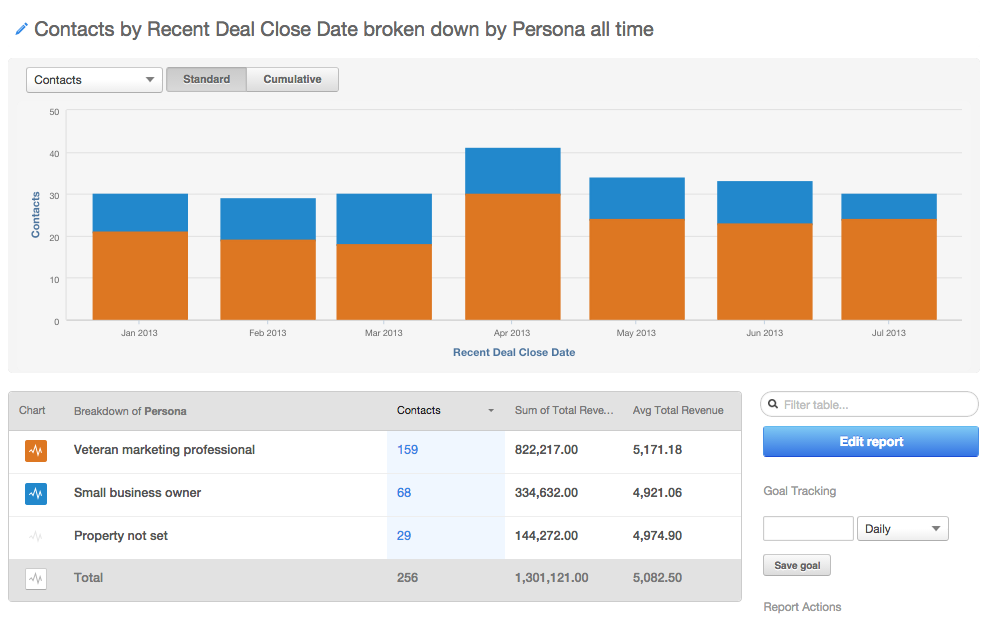
Most marketers are concerned about building a strong relationship with their sales team. After all, the marketing team is supposed to generate leads and assist the sales team in closing deals for the company. To make all of that happen, these teams need to have a good relationship.
But any marketer can tell you that there can be tension between the marketing and sales teams. It could happen for many reasons — the leads number could be down, the quality of leads could be down, or there could simply be clashing team priorities (among other things).
To prevent those troubles from coming up, it’s best to have aligned goals and metrics between the two teams. One great way to do this is to have the marketing team talk about the number of leads they generated and the amount of revenue their efforts helped generate for the company. Revenue is a number everyone in the business knows and cares about, making it much easier for your team to justify your efforts to the sales team.
But many marketers aren’t familiar with tying their efforts to revenue. If you’d like to learn a few ways to use revenue reporting to improve your sales/marketing alignment, keep on reading. And if you are a HubSpot customer, learn how you can report on revenue using HubSpot!
Helps You Discover the Revenue-Generating Channels
Your marketing team should have a leads goal that you are trying to hit on a monthly basis. But it is also important to understand how those leads are eventually turning into revenue for the company. Tying the company’s revenue back to individual marketing efforts can go a long way in helping you and your team prioritize.
For example, let’s say your marketing team is trying to decide where to invest the team’s time and resources. They may even be considering hiring someone new for the team but aren’t sure where those resources should go.
Revenue reporting can help. Run a revenue report based on channel to see the different areas of your marketing that are generating the most amount of revenue for the company. That way you can decide where to invest your resources based on the channels that are producing the most revenue for your company.
The report below is an example that shows the amount of revenue generated by each marketing channel.

From this report above, we can see that the most amount of revenue is generated by your email marketing efforts. However, if we look at the average amount of revenue generated by company, the other campaigns, direct traffic, and paid search efforts are generating the most. If you’re trying to figure out where to reallocate your efforts, you might want to put more time, effort, and money into the latter three buckets. Or you could dive into those channels to see what worked for them, and try replicating them in your highest total revenue channel (email).
Note: It is important to take into account how much you have been spending on each channel. For example, paid search may be generating the most revenue for your company, but if you are spending more on that channel than others, you might not want to (or be able to) invest more in that channel.
Helps You Identify the Content That Closes High-Revenue Deals
There are different types of content that you need to provide as a marketer. You need to provide content that will attract leads to your site and get them interested in your product and service. Youl also need to create content that nurtures your leads, shows them the value of your product or service, and ultimately helps turn them into a customer. These types of content can be extremely different, but all are an important part of moving someone through the buying journey.
Want to figure out what types of content could help you better support your sales process? Build reports that show you the amount of revenue generated by these conversions. This information will help you understand what content helps close some of the larger revenue deals and also what content may not be generating as much revenue for the company as you think. This will then help you decide what topics you should write about and in what formats. For example, you may think that your ebooks are helping close customers when it’s really your whitepapers that are helping. Or you may think that one topic is what customers are asking for but that isn’t what the revenue data shows.
Let’s take a look at the example below. This report shows different conversion events that led to revenue for the companies. These include but are not limited to webinars, trial requests, and various in-person events.

By looking at this report, I see that the Q1 webinar and marketing automation RFP have generated the most amount of revenue for the company. When I look at how much revenue has been generated overall and by company, the RFP has been the most successful. The webinar is a close second. This tells me a few things. First, both the webinar and RFP provide a ton of detailed information. Sure they are in different forms, but they are both long pieces of content that go into a lot of detail. That tells me that my audience appreciates that type of information and gives me a better idea of how I should format my content going forward if we’re trying to optimize for revenue.
Next, I will dig into the topic around the Q1 webinar. If it has to do with marketing automation, I will know that this is a hot topic for my contacts — the RFP was also on marketing automation. That means I should probably create more content about marketing automation.
Something else to note is that these are all of the pieces of content that helps closed deals. By understanding what pieces of content close customers vs. leads, you could provide this information sooner in the sales cycle to potentially close deals at a quicker rate.
Helps You Justify Your Budget Investments
How do you decide whether you should run a campaign again? How do you decide what marketing channels to invest more heavily in?
You may find out that you generated 100 leads from a particular campaign. But it isn’t clear how many of those leads will actually buy your product or service. By attaching revenue to every single marketing effort, you are able to tell how many higher quality leads your marketing has generated. This information gives you much better insight to decide what to keep and cut from your marketing as you know what will actually generate more business for your company.
To see this in action, let’s take a look at the following revenue report. This report shows how much revenue different personas are generating for the company. As you can see, the veteran marketing professional is generating a lot more revenue than the small business owner for this particular company.

As you are allocating resources to your marketing and sales teams, this is an important figure to take into account. If you are figuring out how many sales reps and marketers should be dedicated to different personas, this report is very telling in how you should make your decisions. The veteran marketing professional persona is generating much more revenue than the small business owner. That doesn’t mean you should give up on this persona, but it does mean that you might think about put more of your company’s resources into the veteran marketing professional persona efforts.
Helps You Speak Their Language
Last, but certainly not least, reporting on revenue can help you relate to your sales team on a much higher level. Sales focuses on the amount of revenue they are generating on a daily basis. By being able to talk in the same language and explain how much revenue your marketing efforts are generating, you will have more productive conversations. Try it out and see how your teams’ relationships improve.
What are some of the other benefits you’ve found with reporting on your revenue?
![]()




